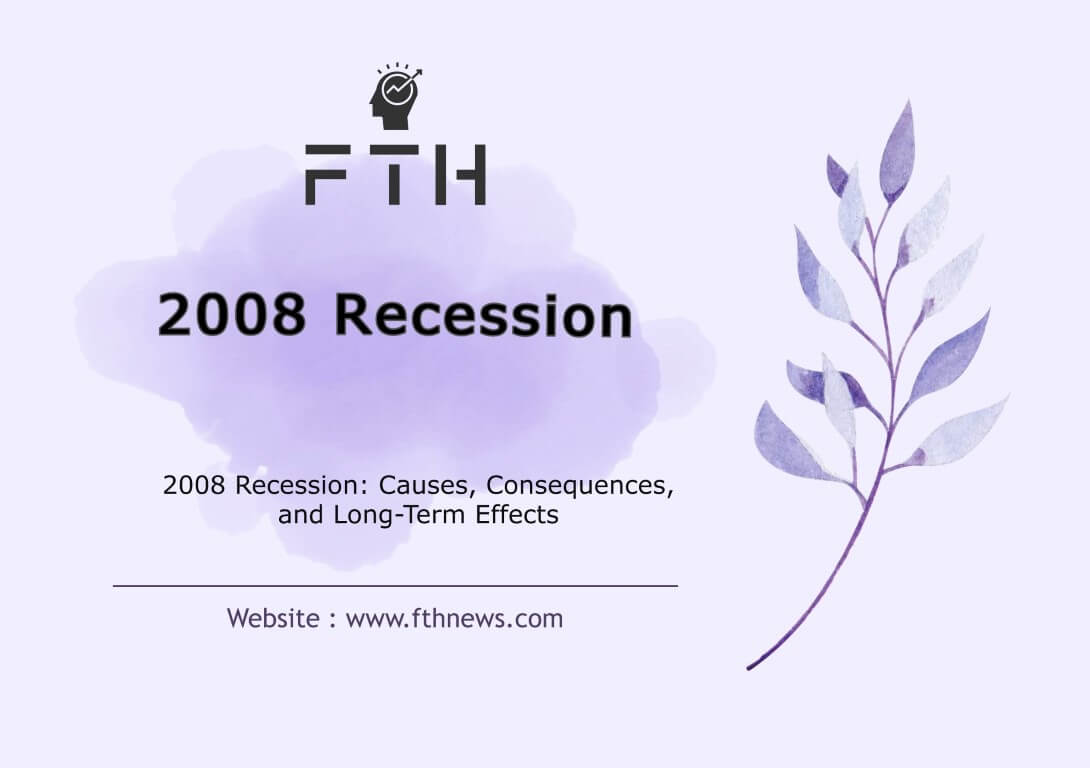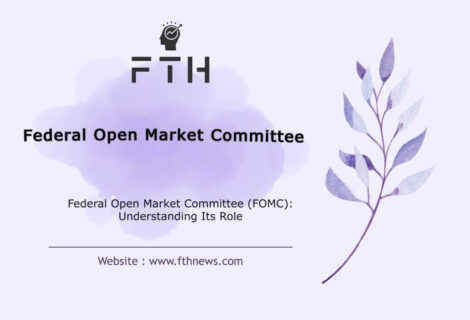
2008 Recession: Causes, Consequences, and Long-Term Effects
The 2008 Recession, commonly known as the Great Recession, stands as a pivotal moment in economic history, comparable to the profound impact of the Great Depression of 1929. Emerging initially as a financial crisis within the United States in 2007, its seismic effects swiftly surpassed national boundaries, triggering an unparalleled global financial and economic meltdown. In this blog post, we will meticulously explore the intricate causes, far-reaching consequences, and enduring impacts of the 2008 Recession.
Understanding the 2008 Great Recession
The 2008 Great Recession, often referred to simply as the 2008 Financial Crisis or the Global Financial Crisis (GFC), was a severe worldwide economic downturn that began in the United States and quickly spread to other parts of the world. It is considered one of the most significant financial crises since the Great Depression of the 1930s.
The roots of the 2008 Great Recession can be traced back to a combination of factors, including:
Housing Bubble Burst:
The crisis was triggered by the bursting of the United States housing bubble, which had been fueled by a speculative boom in real estate prices. As home prices began to decline, it led to a wave of mortgage defaults and foreclosures.
Subprime Mortgage Crisis:
A key factor was the widespread issuance of subprime mortgages (high-risk loans) to homebuyers with poor credit histories. When these borrowers started defaulting on their mortgage payments, it had a cascading effect on the financial system.
Financial Institution Failures:
Major financial institutions faced severe stress as they held large amounts of mortgage-backed securities (MBS) tied to subprime loans. The bankruptcy of Lehman Brothers in September 2008, one of the largest investment banks, marked a critical moment in the crisis.
Global Financial Contagion:
The interconnected nature of the global financial system meant that the crisis quickly spread to other economies. Banks and financial institutions around the world suffered losses, and international trade and investment were significantly impacted.
Credit Freeze and Economic Contraction:
The crisis led to a freeze in credit markets as banks became reluctant to lend money. This credit crunch had a profound effect on businesses and consumers, causing a contraction in economic activity.
Government Interventions:
To prevent a complete collapse of the financial system, governments and central banks implemented unprecedented measures. These included bank bailouts, monetary stimulus, and various financial rescue packages.
The consequences of the 2008 Great Recession were widespread and profound. It resulted in a global economic downturn, a significant increase in unemployment, a decline in consumer and business confidence, and a long-lasting impact on financial markets. Governments and central banks implemented various measures to stabilize economies and prevent a full-scale depression.
The Great Recession had a lasting impact on economic policies, regulatory frameworks, and public perception of financial institutions. It prompted a reevaluation of risk management practices and led to substantial reforms in the financial sector. Even a decade after the crisis, its effects continued to be felt, emphasizing the importance of learning from such events to build a more resilient and stable global economy.
Causes of the 2008 Economic Crisis:
The 2008 Economic Crisis, often referred to as the Great Recession, had its roots entwined in a complex web of financial intricacies that unfolded on a global scale. Let’s delve into the key factors that sparked this momentous downturn:
Excessive Household Debt:
The roots of the 2008 Recession lie in widespread excessive household debt, notably in the USA, Europe, and other developed economies. As households faced mounting debt, financial repercussions cascaded, becoming a pivotal crisis catalyst. This strain on finances resonated globally, marking a critical moment in the global economy’s path.
Subprime Housing Loans and the Rise of “Exotic Securities”:
At the epicenter of the crisis was the precarious practice of banks issuing “Subprime Housing Loans” to low-income and low-credit groups in the USA. In a perilous financial game, banks, enticed by low-interest rates, extended substantial loans without adequately assessing the associated risks. This reckless lending spree gave rise to a novel class of financial instruments known as “exotic securities.” These derivative products, intricately tied to the volatile real estate market, gained popularity but ultimately played a significant role in the eruption of the crisis.
Lehman Brothers Bankruptcy and Global Trust Erosion:
The seismic shock of the 2008 Recession peaked with Lehman Brothers’ unprecedented bankruptcy in September 2008. The fourth-largest U.S. investment bank crumbled under a staggering $613 billion debt, eroding global trust in banks, financial markets, and institutions. Lehman Brothers’ collapse aftermath urged worldwide economic and monetary authorities to urgently implement untested policies, symbolizing a critical turning point in the crisis’s trajectory.
These interconnected factors, from rising household debt to the risky proliferation of subprime loans and Lehman Brothers’ catastrophic collapse, collectively set the stage for an unparalleled crisis. The enduring impact left an indelible imprint on the global economic landscape, shaping the narrative of the Great Recession.
Consequences of the 2008 Economic Crisis:
The repercussions of the 2008 Economic Crisis rippled through the fabric of the global economy, leaving an enduring impact on various fronts:
Prolonged Global Economic Recession:
The crisis cast a long shadow, plunging developed economies into a ten-year recession. This prolonged downturn profoundly affected industries, businesses, and individuals, reshaping global economic growth. A substantial contraction in global foreign trade volumes occurred, with developing countries experiencing indirect consequences through reduced trade opportunities and plummeting commodity prices.
Escalating Unemployment and Widening Income Inequality:
As the crisis unfolded, unemployment rates soared to unprecedented levels worldwide. The economic downturn led to significant deteriorations in income distribution, exacerbating disparities among different socioeconomic groups. Monetary expansion policies and austerity measures implemented by governments aimed at stabilizing economies inadvertently contributed to the exacerbation of economic challenges faced by many individuals and households.
Financial Market Turmoil and Massive Losses:
The turmoil extended to the heart of the financial sector, with financial institutions grappling with massive losses. Approximately $2 trillion in assets evaporated from the portfolios of these institutions, highlighting the magnitude of the financial upheaval. The economic downturn’s cost surpassed $10 trillion, prompting governments and monetary authorities to respond with unprecedented fiscal, monetary, and regulatory interventions. The measures implemented sought to stabilize financial markets, restore investor confidence, and pave the way for economic recovery.
Legislative Reforms in the Financial Sector:
The crisis laid bare significant gaps in legislation regulating securities markets, prompting a comprehensive review of financial regulations. Governments worldwide identified areas for improvement and enacted a series of legislative changes to enhance transparency, oversight, and risk management within the financial sector. These reforms aimed to prevent a recurrence of the vulnerabilities that contributed to the 2008 Economic Crisis, fostering a more resilient and secure financial landscape.
As the global economy gradually emerged from the shadows of the 2008 Economic Crisis, the enduring effects of the recession continued to shape economic policies, financial regulations, and the collective mindset of nations worldwide. The lessons learned from this pivotal moment in history set the stage for a renewed commitment to stability, sustainability, and resilience in the face of future economic challenges.
Long-Term Effects of the 2008 Economic Crisis:
The seismic shockwaves of the 2008 Economic Crisis reverberated for years, leaving an indelible mark on various aspects of the global and national economies:
Wealth Erosion and Lingering Economic Strain:
The aftermath of the crisis was felt deeply in American households, where a staggering net worth reduction of approximately $17 trillion unfolded—a stark 26% decrease in wealth. This economic setback persisted, with the GDP a decade later still grappling with a roughly 7% deficit compared to the trajectory it would have followed without the crisis. The long-lasting impact on wealth and economic growth underscored the enduring challenges posed by the crisis.
Unemployment Prolongation and Deepening Economic Disparities:
The employment landscape bore the brunt of the crisis, enduring a slow and uneven recovery. Despite efforts to revive job markets, the scars of unemployment lingered, shaping the trajectory of economic growth. This prolonged jobs crisis exacerbated economic inequality, creating a stark divide among different segments of the population. The discontent stemming from these disparities found a voice in movements like Occupy Wall Street, reflecting the public’s frustration with the unequal distribution of economic gains.
Government Interventions, Regulatory Reforms, and Fiscal Policies:
Governments worldwide responded robustly to the crisis, implementing a spectrum of measures aimed at stabilizing financial markets and averting future economic catastrophes. The Troubled Asset Relief Program (TARP) played a pivotal role, injecting capital into troubled institutions to restore stability. Additionally, various monetary policies were deployed to stimulate economic growth and rebuild trust in financial systems. Legislative reforms in financial regulations sought to address vulnerabilities exposed by the crisis, fostering a more resilient and transparent financial landscape.
Global Economic Paradigm Shift:
The 2008 Economic Crisis prompted a reassessment of economic paradigms globally. Governments, financial institutions, and policymakers reconsidered their approaches to risk management, fiscal responsibility, and the role of regulatory frameworks. The crisis catalyzed a shift towards a more cautious and vigilant approach to economic policies, with an emphasis on preventing excessive risk-taking and ensuring the stability of financial systems.
Ongoing Impact on Policy and Economic Mindset:
The lessons learned from the 2008 crisis continued to shape economic policies, guiding governments toward more conservative fiscal approaches and robust regulatory frameworks. The collective mindset of nations underwent a transformation, with a heightened awareness of the need for resilience in the face of economic challenges. The scars of the 2008 crisis remained etched in the memory of policymakers and financial institutions, influencing decisions to mitigate risks and foster a more sustainable economic environment.
As the global economy navigated the aftermath of the 2008 Economic Crisis, the enduring effects underscored the imperative of vigilance, adaptability, and collective responsibility in safeguarding against future economic uncertainties. The legacy of this pivotal moment in economic history became a catalyst for comprehensive reforms and a renewed commitment to building a more resilient and equitable global economic landscape.
Duration of the 2008 Great Recession
The 2008 Great Recession officially began in December 2007 and lasted until June 2009. This period of economic downturn is recognized as the most severe since the Great Depression of the 1930s. The National Bureau of Economic Research (NBER) in the United States, which is responsible for dating business cycles, determined the start and end dates for the recession based on various economic indicators. While the recession officially ended in mid-2009, its impact continued to be felt for several years as economies around the world worked to recover and rebuild
What companies did well during the 2008 Recession?
While the 2008 recession had a widespread negative impact on many companies, there were some that managed to grow and thrive during that challenging economic period. Here are a few examples of companies that saw growth during the 2008 recession:
Walmart:
As a discount retailer, Walmart experienced increased demand as consumers sought to save money during tough economic times. The company’s focus on low prices and essential goods contributed to its growth.
McDonald’s:
Fast-food chains like McDonald’s often perform well during economic downturns as consumers tend to opt for more affordable dining options. McDonald’s, with its value menu and global presence, saw steady growth during the recession.
Procter & Gamble:
Companies producing consumer goods, especially essential and everyday products, tend to remain resilient during economic downturns. Procter & Gamble, a consumer goods giant, maintained strong sales for products like household items and personal care products.
AT&T:
Telecommunication companies often fare well during recessions as people prioritize essential services over discretionary spending. AT&T, providing telecommunications and internet services, was relatively stable during the recession.
Dollar Tree, Inc.:
Similar to Walmart, dollar stores and discount retailers saw increased foot traffic as consumers looked for ways to stretch their budgets. Dollar Tree, offering low-cost items, experienced growth during the economic downturn.
Amazon:
The shift toward online shopping continued during the recession, benefiting e-commerce giant Amazon. Consumers, looking for convenience and competitive prices, increasingly turned to online retail.
Healthcare Companies:
Some healthcare companies experienced growth as healthcare spending tends to be less discretionary. Pharmaceutical companies and healthcare service providers often see stable demand during economic downturns.
It’s important to note that while these companies managed to grow during the recession, the overall economic landscape was challenging, and many others faced significant difficulties. Economic downturns can impact different industries in various ways, and companies that offer essential goods and services often fare better during tough times.
How Bad Was The 2008 Recession
The 2008 recession, often referred to as the Great Recession, was a severe economic downturn that had profound and widespread impacts globally. It was one of the most significant economic crises since the Great Depression of the 1930s. The severity of the 2008 recession was characterized by several key factors:
Global Economic Contraction:
The recession led to a significant contraction of the global economy. Developed economies, especially in the United States and Europe, experienced a recession that lasted for approximately ten years.
Financial Market Disruptions:
The crisis triggered massive disruptions in financial markets. Financial institutions faced substantial losses, with assets worth approximately $2 trillion evaporating. This prompted the implementation of unprecedented fiscal, monetary, and regulatory measures to stabilize the financial system.
Unemployment:
The recession resulted in a sharp increase in unemployment rates worldwide. Many businesses faced financial challenges, leading to layoffs and a decrease in job opportunities. Unemployment rates reached alarming levels, contributing to economic hardships for individuals and families.
Housing Market Collapse:
The crisis originated from issues in the housing market, with the collapse of the subprime mortgage market. Housing prices declined rapidly, leading to a wave of foreclosures and negatively impacting the broader real estate sector.
Global Trade Decline:
The recession had a significant impact on global trade. Foreign trade volumes contracted, affecting both developed and developing countries. Falling commodity prices and reduced demand for goods and services contributed to economic challenges for export-dependent nations.
Government Interventions:
Governments around the world implemented intervention measures to stabilize financial markets and stimulate economic recovery. Programs like the Troubled Asset Relief Program (TARP) in the United States aimed to address the crisis’s immediate financial impacts.
Long-Term Effects:
The 2008 recession left lasting effects on the global economy. Long-term consequences included wealth loss for households, slow economic recovery, increased income inequality, and changes in regulatory frameworks to prevent similar crises.
In summary, the 2008 recession was a profound and multifaceted economic crisis that impacted various sectors of the global economy, leading to widespread financial challenges and long-lasting consequences.
What did the government do for the Great Recession of 2008?
During the Great Recession of 2008, governments around the world took various measures to mitigate the economic fallout and stabilize financial systems. Here are some of the key actions taken by governments during that time:
Fiscal Stimulus Packages:
Governments implemented large-scale fiscal stimulus packages aimed at injecting funds into the economy to boost demand and create jobs. These packages included infrastructure spending, tax cuts, and direct assistance to households and businesses.
Monetary Policy Interventions:
Central banks, such as the U.S. Federal Reserve, lowered interest rates to historic lows to stimulate borrowing and investment. They also engaged in unconventional monetary policies, such as quantitative easing, to increase the money supply and support financial markets.
Bailouts and Financial Assistance:
Governments provided bailouts and financial assistance to struggling financial institutions to prevent systemic collapse. This involved measures like capital injections, asset purchases, and guarantees to stabilize banks and restore confidence in the financial system.
Regulatory Reforms:
Governments implemented regulatory reforms to strengthen oversight of the financial sector and address the underlying causes of the crisis. This included measures to enhance transparency, risk management, and capital requirements for financial institutions.
Foreclosure Prevention Programs:
Many governments introduced foreclosure prevention programs to help homeowners facing mortgage difficulties. These programs aimed to modify loan terms, provide refinancing options, and prevent foreclosures to stabilize the housing market and support affected households.
Unemployment Benefits and Social Safety Nets:
Governments expanded unemployment benefits and social safety nets to assist individuals and families impacted by job losses and economic hardship. These measures included extended unemployment insurance, job training programs, and assistance for basic needs like housing and healthcare.
International Cooperation:
Countries coordinated their efforts through international organizations like the G20 and the International Monetary Fund (IMF) to address the global nature of the crisis. This cooperation involved policy coordination, financial assistance to affected countries, and initiatives to reform international financial institutions.
Overall, the government responses to the Great Recession of 2008 were aimed at stabilizing financial markets, restoring confidence, and mitigating the adverse economic impact on individuals, businesses, and communities. These measures played a crucial role in supporting economic recovery and laying the groundwork for long-term financial stability and resilience.
Conclusion:
The 2008 Economic Crisis, born from a complex interplay of factors, significantly impacted the global economy. While substantial efforts have been made to recover and reform, its enduring effects persist. Understanding the lessons from this crisis is crucial for fortifying the global economy against future uncertainties. As societies navigate the aftermath, a collective commitment to vigilant risk management, transparent financial practices, and equitable economic growth is imperative. The 2008 crisis serves as a stark reminder of the fragility inherent in economic systems, urging us to prioritize resilience and adaptability.
FAQ
Barack Obama was the President of the United States during the 2008 recession. He took office on January 20, 2009, succeeding George W. Bush. The recession had already started during the latter part of George W. Bush’s presidency.














